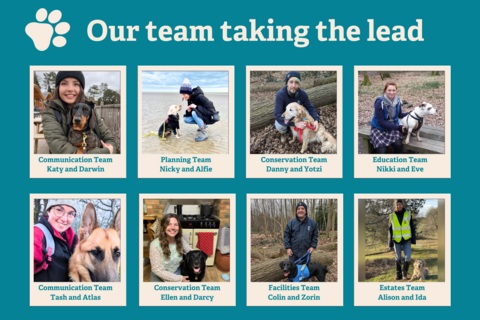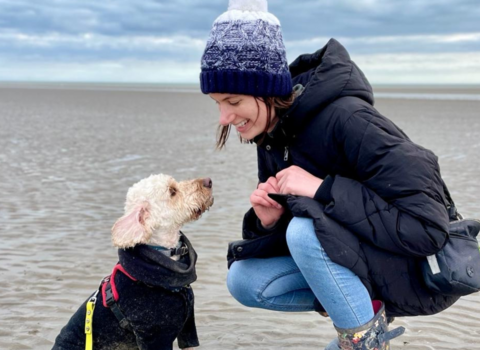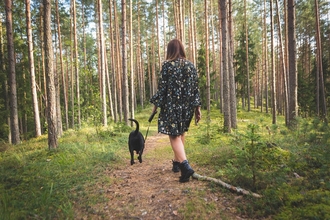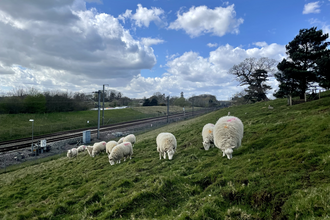Dogs have been our beloved companions for thousands of years and continue to be owned by millions of people worldwide.
Although dog-walking may seem like an innocent pastime, it can have an impact on wildlife. We understand the importance of striking a balance between enjoyable dog-walking and protecting wildlife.
Dog-walking is an extremely popular outdoor activity for both owners and their furry friends, with a recent report by Natural England revealing that there are approximately 1.5 billion visits to the countryside with dogs.
We also recognise the significant role dogs play in enriching people's lives (many of us being dog owners ourselves), but this also brings a level of responsibility. That's why we are asking you to "Take the lead for nature" and follow a few simple steps to help protect wildlife whilst walking your pet.

Minimise harm to small, tricky-to-spot animals
Dogs evolved as a predatory species. Even though they now spend 90% of their time dozing in the sunshine in our houses, safe, warm and well-fed, our wildlife hasn't got the memo. They still treat dogs in their habitats as predators. Much of the fun that dogs have when they are out and about is practising those hunting actions, even if they never actually catch anything. As such, it still has wide-ranging effects on our wildlife.
- Animals that nest close to the ground such as robins, blackbirds, harvest mice, hedgehogs and some shoreline birds will abandon nests and their young if they are disturbed too often. The parents themselves may get sick and hungry from the impacts of having to flee too often meaning they can't provide their young with enough food to grow up, and in the worst-case scenario, defenceless, young animals on the ground may get killed or eaten. Watch this video of ground-nesting birds.
- Animals fleeing from a hunting dog such as bank voles, rabbits or squirrels can injure themselves in panic, even if the dog doesn't catch them, leading to their death, often unseen by passersby. These small creatures may often feel the need to flee when a dog comes close even if it hasn't noticed them.
- Animals that are camouflaged and lie in wait for their food, or while they rest, such as frogs and toads, are especially affected by disturbance, giving away their location as they are forced to move. This can quickly lead to them getting hungry and cold and reducing their chances of survival significantly.
Predators in the environment are a perfectly natural part of the cycle of most ecosystems. Normally the number of predators is controlled by the availability of wild food. In the case of animals such as dogs, we now have far more of them out and about than the habitat would naturally cope with and so we need to manage their impacts giving everything space to live.
The best way to reduce the pressure our dogs put on the wildlife that shares our favourite walks is to keep them on the paths and tracks and out of the places where the wildlife is resting, feeding and nesting. Dogs should be kept out of long, rough grass, bramble and scrub thickets, woodland understory, marshes and reedbeds and away from coastal mudflats and shingle banks.
If you have good voice control, that can be off lead, but for most of us, with active, curious dogs, we will need a short lead to manage how far they range into the rough grasses, coastline and undergrowth. Some of our native wildlife can give a nasty bite too, such as adders or stoats if cornered under a log pile, so keeping your pets on the trails is safest for them too.
Polite heel walking is the bane of many dog owner's lives. Anyone who has had a dog will have struggled with this at some point. This is when it is tempting to let your dog off even when you know they may cause a nuisance or harm. There are many ways to get help with this. For instance, The Kennel Club Good Citizen scheme is a fun way to help your dog learn to sit, stay and recall in distracting environments. Many places offer these short courses and they aren't too expensive.
Each session is cheaper than a cinema ticket and a great way to spend quality time bonding with your dog and making new dog-walking friends. The trainers may have lots of other ideas for how you and your dog can have fun together while continuing to build your bond and your control too. Not all trainers suit all people, so swap to other classes if you feel the first one you find isn't the right fit for you.
Looking out for others
For dog lovers, it can be difficult to imagine anyone NOT feeling the same, but it is important to recognise that some people may be fearful or anxious around your pet. It may be distressing for them if your dog approaches and jumps up, pawing their arm, or otherwise getting in their space.
Some sites have anglers or picnickers who's visit could be ruined by a dog getting involved. Not to mention your dog getting poorly from eating something they shouldn't
Nature lovers often spend a long time setting up and waiting for a glimpse or a photo of their favourite animal. A dog getting too close could undo all this hard work or damage very expensive equipment
Many dogs need space from other dogs. An elderly dog snoozing in the sun while their owner watches the butterflies in a summer meadow could get accidentally hurt by a boisterous approach.
The law around dangerous dogs states it is an offence to 'allow a dog of any type to be dangerously out of control in a public place' this means if they are acting in a way that may cause harm, then they fall under the act. They don't have to be a certain breed and they don't have to bite. Knocking someone down, including small children or vulnerable adults, would be an offence under the dangerous dogs act.
What I can do?
Keep your dog under control at all times and on a lead. Teach your dog that they receive no attention for jumping on you or anyone else. You can turn your back and only reward your dog when all four paws are on the floor. Teach your dog to do something that is incompatible with jumping up, such as sitting. They can't sit and jump up at the same time.
Remember to make training fun - reward your dog well for sitting out in the field. What's their favourite thing? It's a big deal asking them to sit when surrounded by so many exciting distractions. There are lots of online resources to help with recall training too but most of these boil down to using a lead or longline to prevent them from running off whilst you create an automatic response to a call by playing and having fun with your dog each time you use their name and a cue word. Exploring our natural world is so much more fun when you do it together.
Consider how your dogs treatments impact nature
Unfortunately, external anti-parasite medications can threaten wildlife if you allow your flea-treated pooch to swim in lakes, ponds and rivers.
These products incorporate chemical pesticides like imidacloprid and fipronil, two neurotoxic substances that appear in many treatments. The spot on ones are particularly prone to washing off if you bath your dog regularly or if he goes into water on your walks. Because flea treatments kill a wide range of insects they can also harm wild insects, and the animals that feed on them, that live in our rivers and lakes.
Parasite treatments for dogs are already contaminating waterways worldwide. The University of Sussex revealed in 2020 that fipronil and imidacloprid levels surpassed safe limits in English rivers.
What can I do?
Consider using a tablet-based combined flea and worm treatment from your vet. Alongside picking up your dogs waste, you can radically reduce how much of these nasty chemicals are going into water courses. Many over-the-counter medications are now largely ineffective, as many pet fleas are now resistant, encouraging you to overdose when the initial treatment fails - if only our wildlife was as resistant. Developing a good quality parasite control program with your vet can mean that you minimize the dose you have to give and are more effective in treating those that are dangerous to your animal.
Think about after the treatment. If you have to use topical chemicals, small changes to where our pets go after treatments can reduce the amount of pesticides entering our water courses. Don't go for a walk in the rain, bath them or take your pet swimming for at least a week after spot-on treatments, and avoid washing pet bedding too often; remember topical flea treatments in the drain get into our river systems easily causing destruction once they do.
Ask for non-toxic alternatives. Pet stores, local people, and veterinary practices will all have good ideas on less toxic alternatives you can use instead of topical pesticides to treat a flea infestation, so do your research and ask the experts for other options.
The right walk in the right place
For many people, particularly if walking alone, having a dog with them gives them the confidence to explore the countryside. Access to biodiverse natural spaces is vital to our wellbeing and dogs are the key that unlocks this for many of us. The shared experience can be very powerful.
Nature reserves are spaces for nature first and foremost, and for people to experience nature. With a well-trained and well-behaved dog under control, there is no reason why you can't enjoy the spaces together without causing any additional impact.
With nature in decline, it's more important now than ever to help our precious wildlife thrive free from panic attacks caused by curious dogs and thundering paws. If your dog seems to particularly enjoy heading out to a nature reserve, with barely a backward glance to you, ask yourself why and the answer is likely that it is doing what comes naturally - hunting. Our natural reserves have more wildlife than many other places, so that means more sniffs, smells and things to explore and follow. But is a nature reserve the right place to let them do this?
Often people think it is somewhat delightful watching their pooch head off in chase of a squirrel or bird, after all - they never catch it/it got away. But remember, the panic and stress that an animal would have endured is very high. It may die as a result or struggle to feed or provide for its young. Something that seems so innocent and fun, has dire consequences and it is often overlooked because it goes unseen.
What can I do?
Before you set off for your walk, ask yourself if the nature reserve is the best place for the walk you want?
If you want somewhere for your young, fit pup to race about safely maybe consider using a secure field. These can be hired all across the county and are safe places for your dogs to let loose all that pent-up energy. get together with their doggy friends to share the cost and know that they are interacting with safe playmates.
If you want somewhere for your dog to sniff, explore, meet other dogs etc, maybe a park is a better fit. You still need a good recall and to take account of all the other site users but a site that is purpose-built for amenity will be more robust than a nature reserve.
If you want to immerse yourself in nature, train your dog accordingly before you head out. They should be quiet, calm and under close control, to give you both the best chance to see, hear, smell and take in all the wonders of our natural world.
If there are dog control zones remember it has been put in place to protect wildlife that is struggling to thrive. Look out for signage that restricts access to dogs and adhere to them.
Check websites before you go so that you know what you can and can't do with a dog on-site. If you want to understand more about why dogs are restricted at certain of our nature reserves then you can email us.
Dog poo
We appreciate the vast majority of dog owners pick up after their pet.
At one of our most popular dog-walking reserves, Bluebell Hill, the walkers manage to fill a dog waste bin per day. Whilst our wardens to have to pick up some that is left, we estimate that around 98% of walkers are disposing of waste properly.
However, this is not a trend that is replicated from reserve to reserve and some of the more remote wildlife sites fall foul of foul!
A recent study revealed that dog waste left on nature reserves is creating nitrogen and phosphorus levels that would be illegal on farms.
This can impact varieties of plant and animal life and interactions between species. Scientists said that higher nutrient levels lead to increased plant growth, mostly by a limited number of nutrient-demanding species, that will outcompete the specialists, which our nature reserves are justly famous for.
Worming your dog regularly is the responsible thing to do. A good quality wormer will protect your dog against lungworm, heart worm and intestinal parasites. However, these chemicals are insecticides (they are designed to kill insects). This means that dog mess left on the reserve is highly likely to be adding to the catastrophic insect decline our country is facing. Chemicals wash into the soils when it rains and, however grim it might appear to us, many insects feed and drink directly on various types of poo, as they can extract minerals and salts they need from them.
If you don't worm your dog, you won't be putting these chemicals in the soil if the poo gets left behind, but you are leaving behind a potential source of infection for dogs and other animals.
Many of the dog poos we pick up have paw prints on them where other animals have accidentally stood in it. It's horrible when we stand in it, but animals will clean themselves the only way they can, by licking and therefore ingesting the worms. When other animals accidentally ingest dog mess, such as our grazing cattle, the effects can be fatal.
Dog worms in cattle are untreatable and lead to liver damage and eventually death. Other parasites carried in dog poo are one of the primary causes of miscarriage in cattle. Horses have been known to eat bagged dog poo, attracted to the high levels of grain remaining in the poo or the corn starch bags themselves, leading to colic and death.
What can I do?
Keep a watchful eye on your dog and when it poos, pick it up and dispose of the waste properly in a bin. Nearly all bins in Kent now accept bagged dog waste. You don't have to find a special poo bin. Please don't 'stick and flick' on any Kent Wildlife Trust site. Our staff and volunteers who cut back the path edges to maintain your access will thank you for it.
Many of our nature reserves are beautiful and wild, and they don't have bins on them, as the cost of servicing them is prohibitively high. Carrying dog poo makes a walk much less pleasant but you can invest in specially designed poo bag carriers that free up your hands and keep the smell well contained so that you can get it home safely and hygienically. This also means you won't forget to collect it on your way back from your walk either.
Avoid buying green or black poo bags, they blend in well and make it easy to miss. A bright colour means this is less likely, and it means our staff and volunteers out cutting back the paths are less likely to hit them too if they do get forgotten.
Dogs around livestock
Dogs can be a threat to sheep, cows and other grazing livestock – with regular problems reported on land owned or managed by Kent Wildlife Trust.
In one year alone several incidents across our reserves resulted in an injury to a member of staff and 13 sheep killed by out of control dogs. Many other sheep were found with bite injuries. Cattle sometimes are also injured by dogs and when defending themselves against dogs, with bites and broken horns.
Our livestock are all prey animals, they instinctively expect that an animal like a dog would want to hunt them. It doesn't matter that your dog is feeling playful, or even anxious, they will see running and barking as a sign that your dog wants to attack them. For all our animals this leads to fear and anxiety that changes their behavior and the way they interact with the nature reserve. This means they feed, sleep and interact with each other differently than they would in the wild where the level of predator interaction would be much lower. In some cases this can have noticeable affects on the biodiversity they are there to help create, reducing our chances of success in protecting the wildlife.
Many of our sheep breeds in particular are hill or mountain sheep. They act very differently from the typical commercial white sheep we are all used to seeing. Those white sheep flock together as a safety mechanism against predation. In the mountain habitats where our sheep have evolved, there is not enough room for this to be effective. The terrain is too rough. Instead, they scatter, grazing and browsing in small groups, and when threatened they starburst in all directions and try to hide in nooks and crannies.
They love eating bramble and woody vegetation so they are often out of sight in trees and bushes. They don't keep their lambs with them. They hide their lambs in little groups, in tree hollows, for instance, go out to forage and then return to feed them. This is an adaption to the harsh mountain climate. However, all this means that sometimes people feel it is ok to let their dog off the lead around the sheep because they think they either aren't in the field that we've signed or that they have left the flock behind them. This is when accidents happen as the dog can smell very easily what you can't see.
For cattle, if they can't move far enough away from the dog to feel safe again, this can lead to them retaliating against the dog that is 'attacking' them. All of our cattle are temperament tested as a part of their daily welfare checks, with slight changes in attitude and confidence toward the public noted and if necessary actioned. However, if a dog does attack them, any of them may defend themselves. Horses will also kick and bite to defend themselves if they feel unable to escape a running or barking dog.
Dog owners can help wildlife if they:
- Keep dogs on short leads if you can't depend on them to stay close to you and always around vulnerable sheep and goats
- Keep dogs as far away from livestock as possible. Adjusting their route to use another path or field if their dog isn't calm around livestock.
Top tips
We always recommend 10m as the minimum safe distance for the public but if you have a dog with you, it's best to make that distance even bigger. Keep an eye on the animals. If they are continuing to graze or rest then you are far enough away. If they stop what they are doing to turn and look at you, or if they start moving away, you are too close and causing them to be wary, or even fearful. Give them more room by adjusting your heading or turning back and choosing a different path.
Train your dog to focus on you with a 'watch me' cue or a silent toy as you move past so they aren't staring, lunging or barking at the animals. You can use this for any wildlife too. Placing your dog on the opposite side of you to the animals often helps to calm a nervous dog.
Avoid using nature reserves if walking large groups of dogs, particularly with livestock as packs are inherently more scary to animals than solitary hunters and it's harder to keep each animal under calm control if something were to go wrong.
Only if the large animals go for your dog, should you let it off the lead to escape, as it can run faster and turn sharper than most large animals. Some people believe their dog is safer off lead around large animals but this is not the case. Allowing the dogs to move naturally around the animals tends to lead them to their natural hunting and stalking behaviour which makes the cattle and horses more likely to feel the need to defend themselves.
Keeping them at heel and moving parallel and past a group of grazing animals instinctively signals that the dog is just moving through the space and not looking for it's next meal.


